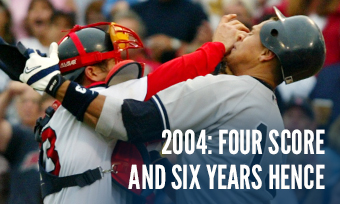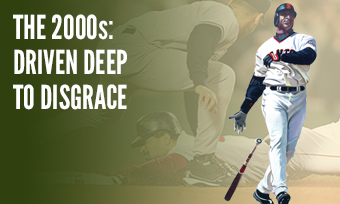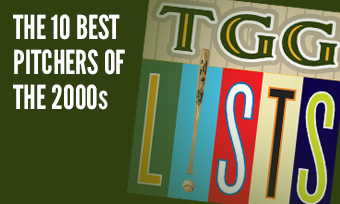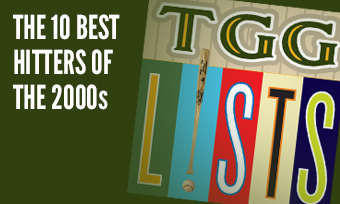The Yearly Reader
Leaders and Honors, 2004
Our list of baseball’s top 10 hitters and pitchers in both the American League and National League for the 2004 baseball season, as well as the awards and honors given to the game’s top achievers of the year.
The National League’s Top 10 Hitters, 2004
Bold type in brick red indicates league leader.
1. Barry Bonds, San Francisco
Key Numbers: .362 average, 129 runs, 27 doubles, 45 home runs, 101 RBIs, 232 walks, 120 intentional walks, .609 on-base percentage, .812 slugging percentage.
Despite deepening evidence of his alleged steroid use, Bonds was still less vilified on the road than opposing pitchers, who were often booed for running the count to 3-0.
2. Albert Pujols, St. Louis
Key Numbers: .331 average, 133 runs, 196 hits, 51 doubles, 46 home runs, 123 RBIs, 84 walks, 21 grounded into double plays.
It wasn’t all about the home run for Pujols, who for the second straight year collected at least 50 doubles.
3. Todd Helton, Colorado
Key Numbers: .347 average, 115 runs, 190 hits, 49 doubles, 32 home runs, 96 RBIs, 127 walks.
Again proving that he didn’t need Coors Field to justify his star status, Helton his .326 on the road. (But it didn’t hurt that he hit .368 at the Rockies’ mile-high ballyard.)
4. Bobby Abreu, Philadelphia
Key Numbers: .301 average, 118 runs, 173 hits, 47 doubles, 30 home runs, 105 RBIs, 127 walks, 40 stolen bases.
Here’s a stumper for you: In the year that Barry Bonds drew 232 walks, who led the NL in unintentional walks? If you raised you’re hand for Abreu—who set a career high in total passes—congratulations.
5. Jim Edmonds, St. Louis
Key Numbers: .301 average, 102 runs, 38 doubles, 42 home runs, 111 RBIs, 101 walks.
The 34-year-old slugger hit a career acme with personal bests in home runs and RBIs; it wouldn’t be long before the inevitable slide would commence.
6. Scott Rolen, St. Louis
Key Numbers: .314 average, 109 runs, 32 doubles, 34 home runs, 124 RBIs, 13 hit-by-pitches.
In his second full year in a town he described as “Baseball Heaven” after a rocky (though productive) six-plus seasons with the Phillies and their fans, Rolen put up top numbers and was embraced by Cardinals fans who grouped he, Albert Pujols and Jim Edmonds as “MV3.”
7. Adrian Beltre, Los Angeles
Key Numbers: .334 average, 104 runs, 200 hits, 32 doubles, 48 home runs, 121 RBIs.
With free agency looming, Beltre exploded after six years trying to crank his game into high gear, admitting that he was finally doing his homework on pitchers.
8. J.D. Drew, Atlanta
Key Numbers: .305 average, 118 runs, 28 doubles, 8 triples, 31 home runs, 93 RBIs, 118 walks, 12 stolen bases.
The hot-again, not-again Drew, hampered by numerous injuries and uneven results, finally got in a full, pain-free season—and the numbers proved it.
9. Lance Berkman, Houston
Key Numbers: .316 average, 104 runs, 172 hits, 40 doubles, 30 home runs, 106 RBIs, 127 walks, 10 hit-by-pitches.
As an aside to his only campaign going .300-30-100-100-100 (bat average/home runs/RBIs/runs/walks), the switch-hitting Berkman decided to play his weak side (right-handed) at the Home Run Derby—and made it to the final round before bowing to Miguel Tejada.
10. Jim Thome, Philadelphia
Key Numbers: .274 average, 97 runs, 28 doubles, 42 home runs, 105 RBIs, 104 walks, 26 intentional walks.
Thome hit 27 homers through the end of June, ultimately helping to ensure his fourth straight year belting at least 40.
The American League’s Top 10 Hitters, 2004
1. Vladimir Guerrero, Anaheim
Key Numbers: .337 average, 124 runs, 206 hits, 39 doubles, 39 home runs, 126 RBIs, 15 stolen bases.
Guerrero’s AL debut earned him the MVP for a ferocious last-week tear that hoisted the Angels into the postseason.
2. Manny Ramirez, Boston
Key Numbers: .308 average, 108 runs, 175 hits, 44 doubles, 43 home runs, 130 RBIs, 82 walks, .613 slugging percentage.
Manny carried on magnificently at the plate while his relationship with anything Boston continued to grow more tense; the Red Sox at one point even placed him on irrevocable waivers before the season, daring anyone to take him, his baggage and his contract. Nobody did.
3. David Ortiz, Boston
Key Numbers: .301 average, 94 runs, 175 hits, 47 doubles, 41 home runs, 139 RBIs, .608 slugging percentage.
Big Papi emerged as Ramirez’s equal in the Red Sox’ lineup—by the numbers, not by disposition—and began a double-barreled reign of terror upon opponents.
4. Melvin Mora, Baltimore
Key Numbers: .340 average, 111 runs, 187 hits, 41 doubles, 27 home runs, 104 RBIs, 11 hit-by-pitches, 11 stolen bases, .419 on-base percentage.
A late flowering for one of the decade’s more underrated hitters, as the 32-year-old Venezuelan finally put together a solid campaign after seven years trudging through the minors and another five trying to make it in the majors.
5. Travis Hafner, Cleveland
Key Numbers: .311 average, 96 runs, 41 doubles, 28 home runs, 109 RBIs, 17 hit-by-pitches.
Arguably the best major leaguer born in North Dakota, the popular Hafner was a chief component of a second (and more homegrown) wave of talent in the Jacobs Field era with serious postseason ambitions.
6. Miguel Tejada, Baltimore
Key Numbers: 162 games, .311 average, 107 runs, 203 hits, 40 doubles, 34 home runs, 150 RBIs, 24 grounded into double plays, 14 sacrifice flies.
The latest high-priced refugee from payroll-challenged Oakland, Tejada arrived at Camden Yards, emulated Cal Ripken Jr. in the midst of the majors’ fifth-longest consecutive-game streak (1,152) and broke the Baltimore season RBI mark.
7. Gary Sheffield, New York
Key Numbers: .290 average, 117 runs, 166 hits, 30 doubles, 36 home runs, 121 RBIs, 92 walks, 11 hit-by-pitches.
Yankee Stadium became the latest stop for the bristly slugger, tying another new arrival—Alex Rodriguez—for the team lead in home runs.
8. Ichiro Suzuki, Seattle
Key Numbers: .372 average, 704 at-bats, 101 runs, 262 hits, 225 singles, 24 doubles, 5 triples, 8 home runs, 60 RBIs, 19 intentional walks, 36 stolen bases.
One could write a book on all the various achievements accomplished by Ichiro in 2004 beyond the record total in hits, so here’s a few you may not know about: He batted .423 from July 1 on, had five hit streaks of at least 13 games, punched out five hits in four different games and produced 80 multi-hit games—most in the divisional era. Without him, the Mariners drop from sixth in AL team batting…to last.
9. Mark Teixeira, Texas
Key Numbers: .281 average, 101 runs, 34 doubles, 38 home runs, 112 RBIs, 10 hit-by-pitches.
Picking up the power slack for the departed Alex Rodriguez, the second-year switch-hitter paced the Rangers in home runs—with 26 of them hit after July 1.
10. Carlos Guillen, Detroit
Key Numbers: 136 games, .318 average, 97 runs, 37 doubles, 10 triples, 20 home runs, 97 RBIs, 12 stolen bases.
The Tigers got the best of a trade with Seattle that gave them Guillen—who propelled from common-player status to All-Star-level talent, helping to lift Detroit from an infamous 43-119 hole the year before.
The National League’s Top 10 Pitchers, 2004
1. Randy Johnson, Arizona
Key Numbers: 2.60 ERA, 16 wins, 14 losses, 35 starts, 245.2 innings, 44 walks, 290 strikeouts, 10 hit-by-pitches.
Not surprisingly, on a team that lost 111 games, Johnson was given the worst run support of his career. As such, it’s likely he was denied a fifth straight Cy Young Award, which instead went to…
2. Roger Clemens, Houston
Key Numbers: 2.98 ERA, 18 wins, 4 losses, .818 win percentage, 33 starts, 214.1 innings, 23 stolen bases allowed.
Coaxed out of brief retirement by fellow Astros signee Andy Pettitte, Clemens showed the NL what the AL had all too well known for two decades.
3. Eric Gagne, Los Angeles
Key Numbers: 2.19 ERA, 7 wins, 3 losses, 45 saves, 2 blown saves, 70 appearances, 82.1 innings.
Gagne lost his catcher/soul mate in Paul Lo Duca—and then his immortal edge—but remained baseball’s most intimidating closer.
4. Armando Benitez, Florida
Key Numbers: 1.29 ERA, 2 wins, 2 losses, 47 saves, 4 blown saves, 64 appearances, 69.2 innings, 9 stolen bases allowed.
After losing his closer role and bouncing around the majors, Benitez stuck with the Marlins and sizzled like never before.
5. Jaret Wright, Atlanta
Key Numbers: 3.28 ERA, 15 wins, 8 losses, 32 starts, 186.1 innings.
Straddled by continued shoulder issues that greatly limited his play over the previous four years, Wright briefly reached the potential predicted of him by the Indians back in 1997 and proved an agreeable fill-in at Atlanta for the departed Greg Maddux.
6. Carlos Zambrano, Chicago
Key Numbers: 2.75 ERA, 16 wins, 8 losses, 31 starts, 209.2 innings, 20 hit-by-pitches.
The bulky (6.4”, 250 pounds) and sometimes testy pitcher hit 20 batters—the most satisfying might have been his drilling of Jim Edmonds one at-bat after the St. Louis slugger admired a home run he just belted; it led to Zambrano being ejected.
7. Jason Isringhausen, St. Louis
Key Numbers: 2.87 ERA, 4 wins, 2 losses, 47 saves, 7 blown saves, 74 appearances, 75.1 innings.
The Cardinals’ all-time saves leader, Isringhausen saved his best stuff for the road—saving 28 games with a microscopic 1.34 ERA.
8. Jake Peavy, San Diego
Key Numbers: 2.27 ERA, 15 wins, 6 losses, .714 win percentage, 27 starts, 166.1 innings, 16 stolen bases allowed, 1 caught stealing/picked off.
The Padres’ move into pitching-friendly Petco Park may have steamed the egos of their hitter—but it was a boon for Peavy, who grabbed his first of two ERA titles, saw a huge decrease in home runs conceded (from 33 to 13—including just four at Petco) and helped San Diego make a 23-game turnaround in the standings and its first winning record since 1998.
9. Carl Pavano, Florida
Key Numbers: 3.00 ERA, 18 wins, 8 losses, .692 win percentage, 31 starts, 222.1 innings, 49 walks, 11 hit-by-pitches, 3 balks.
Nothing like a career year before hitting free agency, as Pavano squarely did for the Marlins; he leveraged the superior numbers to a sweet contract with the Yankees that they would quickly regret.
10. Jose Mesa, Pittsburgh
Key Numbers: 3.25 ERA, 5 wins, 2 losses, 43 saves, 5 blown saves, 70 appearances, 69.1 innings.
Let go by the Phillies after a miserable 2003, the veteran reliever performed his latest career resurgence, somehow saving 43 games for a Pirates team that sill had trouble shaking the knack for losing.
The American League’s Top 10 Pitchers, 2004
1. Johan Santana, Minnesota
Key Numbers: 2.61 ERA, 20 wins, 6 losses, .769 win percentage, 34 starts, 228 innings, 265 strikeouts.
After proving a year earlier to the Twins that he could be a bona fide starter, Santana wobbled through the first half of 2004—then came absolutely alive after the All-Star Break, producing a 13-0 record and 1.21 ERA while striking out every third batter he faced.
2. Curt Schilling, Boston
Key Numbers: 3.26 ERA, 21 wins, 6 losses, .778 win percentage, 32 starts, 226.2 innings, 35 walks.
Signed away from a rebuilding Arizona side, Schilling ate up the challenge of conquering both the AL East and the Curse of the Bambino; he was 12-0 against teams with winning records.
3. Mariano Rivera, New York
Key Numbers: 1.94 ERA, 4 wins, 2 losses, 53 saves, 4 blown saves, 74 appearances, 78.2 innings.
One reason the Yankees set an all-time mark in come-from-behind wins was that Rivera saved just about all of them.
4. Jake Westbrook, Cleveland
Key Numbers: 3.38 ERA, 14 wins, 9 losses, 33 appearances, 30 starts, 5 complete games, 215.2 innings, 29 grounded into double plays.
Holding Cleveland’s ace mound warm for the emerging CC Sabathia and Cliff Lee, Westbrook gave the Indians a career-low ERA and lone All-Star roster spot.
5. Tim Hudson, Oakland
Key Numbers: 3.53 ERA, 12 wins, 6 losses, 27 starts, 2 shutouts, 188.2 innings, 44 walks, 12 hit-by-pitches, 23 grounded into double plays.
A strong September might have given Hudson a better shot at stealing the ERA title from Johan Santana, but he went the other direction instead (6.23 over the final month).
6. Mark Buehrle, Chicago
Key Numbers: 3.89 ERA, 16 wins, 10 losses, 35 starts, 245.1 innings, 51 walks, 5 stolen bases allowed, 17 caught stealing/picked off, 33 grounded into double plays.
Baffling splits: Buehrle won more games (nine) at home despite an ERA (5.02) nearly twice that of his road (2.63) figure.
7. Francisco Cordero, Texas
Key Numbers: 2.13 ERA, 3 wins, 4 losses, 49 saves, 5 blown saves, 67 appearances, 71.2 innings.
Not to be confused with teammate Frank Francisco—who unfortunately featured in an ugly September brawl with Oakland fans—Cordero set a Rangers record for season saves despite his own ugly September in which he lost all four games, suffered three of his five blown saves and surrendered his only home run of the year.
8. Brad Radke, Minnesota
Key Numbers: 3.48 ERA, 11 wins, 8 losses, 34 starts, 219.2 innings, 26 walks.
The one-time 20-game winner (1997) dealing with slimmer times arguably put together his most efficient campaign, even if the record didn’t necessarily reflect it.
9. Joe Nathan, Minnesota
Key Numbers: 1.62 ERA, 1 win, 2 losses, 44 saves, 3 blown saves, 73 appearances, 72.1 innings.
A sore-armed washout with the Giants, Nathan became the ultimate reclamation project and Johan Santana’s bullpen equal in Minnesota.
10. Keith Foulke, Boston
Key Numbers: 2.17 ERA, 5 wins, 3 losses, 32 saves, 7 blown saves, 72 appearances, 83 innings.
Another team, another sharp performance for the star closer, though his career was down to below a quarter-tank as the nicks and knacks began piling up.









